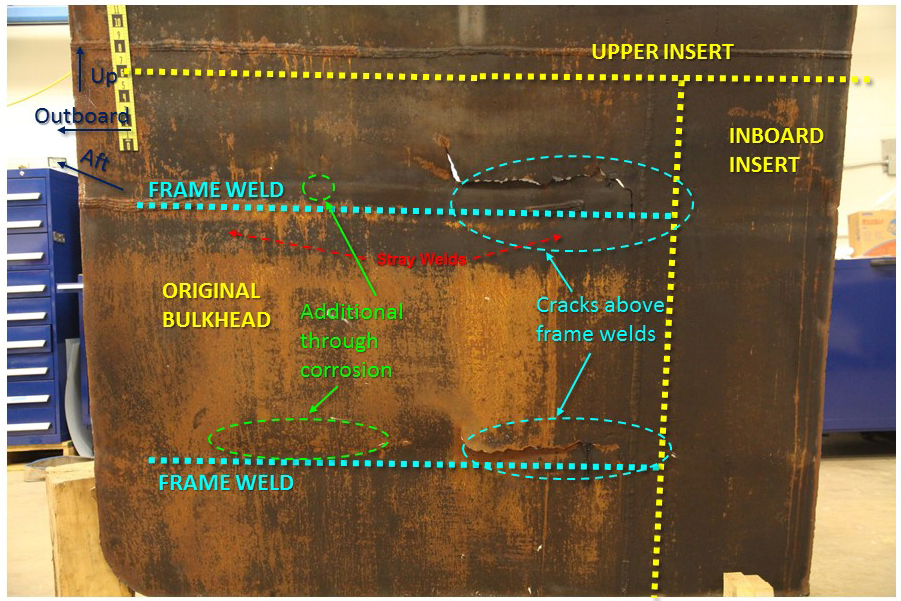WASHINGTON (May 9, 2019) — An explosion and fire aboard a barge was the result of a lack of effective maintenance and safety management of the barge by the Bouchard Transportation Company, the National Transportation Safety Board said in a report released Thursday.
Marine Accident Brief 19/07 states the Oct. 20, 2017, explosion aboard the articulated tug and barge Buster Bouchard/B No. 255 was caused by the ignition of flammable vapor that formed in a void space. The vapor was from crude oil that leaked into the void space from the number one port cargo tank through a corroded bulkhead. Two barge crewmembers who were on the bow were killed in the explosion. About 2,000 barrels of crude oil were discharged from the barge into the water, or, were consumed in the ensuing fire. The barge sustained more than $5 million in damage and was scrapped after the accident. The tugboat was not damaged.

(This photo illustration shows the cargo tank side of the bulkhead section taken from the Buster Bouchard/B No. 255 barge for examination at NTSB Laboratory. The B No. 255 exploded and caught fire Oct. 20, 2017, killing two crewmembers. The photo has been marked up to show areas of replaced/inserted steel, the two cracks, and two additional areas of through-corrosion. NTSB photo illustration)
“The series of failures documented during this investigation highlights the need for effective safety management systems, proper vessel maintenance, and thorough regulatory examinations,” said NTSB Director of Marine Safety Brian Curtis. “If implemented, the recommendations issued as a result of this investigation will help to identify the failures that led to this accident and prevent similar casualties in the future.”
NTSB investigators documented cracks in the area of the original bulkhead that were not repaired prior to the explosion. These cracks compromised the integrity of the cargo containment of the number one port tank. The NTSB’s report noted U.S. Coast Guard inspectors who examined the barge prior to the accident failed to identify unsafe conditions, which allowed the vessel to continue to operate at an increased risk to the crews, the environment and port facilities. Further, the American Bureau of Shipping failed to act on its surveys that also highlighted discrepancies regarding the substandard maintenance and hazardous conditions of B. No. 255.
The NTSB also found no indication of collaborative communications between ABS and Coast Guard regarding deficiencies discovered by either organization prior to the explosion. The lack of communication between ABS and the Coast Guard prevented a coordinated effort to evaluate the structural condition of the tank barge.
The NTSB concluded in its report that the ineffective inspections and surveys by both the Coast Guard and the ABS and failure to correct unsafe conditions contributed to the accident. Based upon the findings of its investigation, the NTSB issued safety recommendations to both organizations seeking the establishment of joint policy and procedures to share information including results and findings from audits, surveys, examinations, inspections and all other applicable activities related to vessel safety.
The NTSB also issued one safety recommendation to Bouchard Transportation Co., Inc., to evaluate their safety management system with a third party to identify deficiencies.
To view findings, probable cause, and all recommendations, visit https://go.usa.gov/xmPnp.
To report an incident/accident or if you are a public safety agency, please call 1-844-373-9922 or 202-314-6290 to speak to a Watch Officer at the NTSB Response Operations Center (ROC) in Washington, DC (24/7).